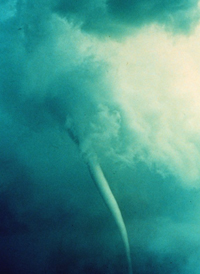Answer to Brain Drain: Winter 2002
The clouds around the tail and cockpit of this plane form for the same reason as rain clouds. What condition causes the clouds to form?

U.S. Navy photo by Ensign John Gay. July 7, 1999.
Clouds form when the temperature of humid air drops. At low temperatures, water prefers the liquid state of clouds rather than the gaseous state of invisible water vapor.
To explain the clouds around the aircraft, Dr. Mark Cramer at Virgina Tech tells us that, "the lowered bulk pressure results in a lowering of the temperature causing condensation of the ambient water vapor."
He says that pressure drops, causing a temperature drop. This results in condensation, the shift of water from the gas to the liquid phase.
The clouds only occur in a localized area because these are the only places that the temperature lowers enough for clouds to form. All around the plane, there is a pattern of higher and lower pressure (pressure waves) caused by the motion of the plane in air. You've probably heard evidence of these pressure waves before: sonic booms.
The same phenomenon occurs:
• When clouds form in association with low pressure. Atmospheric pressure is often low in a band along the equator called the Intertropical Convergence Zone (ITCZ), as seen in the image below. Do you see the line of clouds that typically marks this low pressure area?

Satellite Image of Earth.
Photo Courtesy of NASA
• When it rains, is rain associated with low or high pressure?
• In funnel clouds or tornadoes. You couldn't see these low pressure funnels if water did not condense inside. Of course it might be easier to see Toto whirling around.

Tornado in Union City, Oklahoma, 1973.
Photo courtesy of NOAA Photo Library,
NOAA Central Library; OAR/ERL/National Severe Storms Laboratory (NSSL)
Concept challenge:
If the diagram below is the phase diagram of water, why are low pressure areas associated with liquid phase (clouds and rain) rather than the gas phase ? Doesn't the diagram contradict our association of rain with low pressure? Discuss this in your science or physics class.

Related links:
Picture and movies of clouds associated with supersonic aircraft
http://www.wilk4.com/misc/soundbreak.htm
Spectacular science of fluid mechanics at Dr. Mark Cramer's web gallery
http://www.eng.vt.edu/fluids/msc/gallery/gall.htm
Pressure waves around supersonic aircraft. Nice animation showing the origin of the sonic boom. You'll need the Shockwave plug-in.
http://142.26.194.131/aerodynamics1/High-Speed/Page2.html
USA Today Weather Basics
What's happening inside highs and lows?
http://www.usatoday.com/weather/tg/whighlow/whighlow.htm
Make your own cloud in a bottle
http://freeweb.pdq.net/headstrong/cloudb.htm